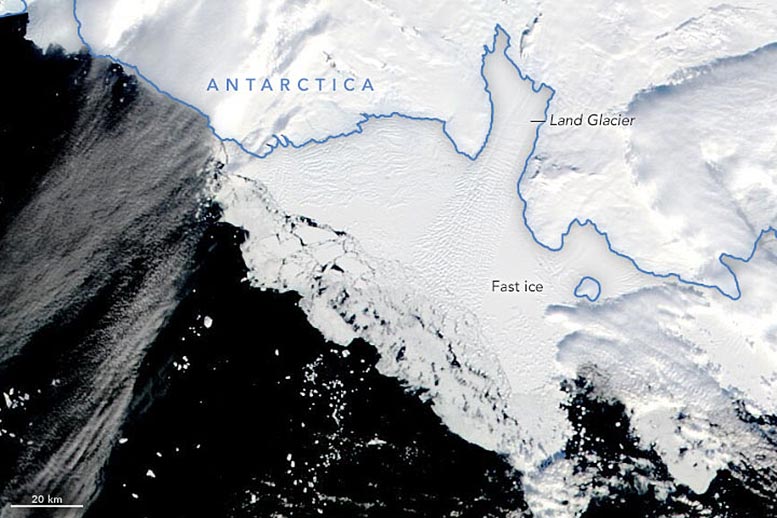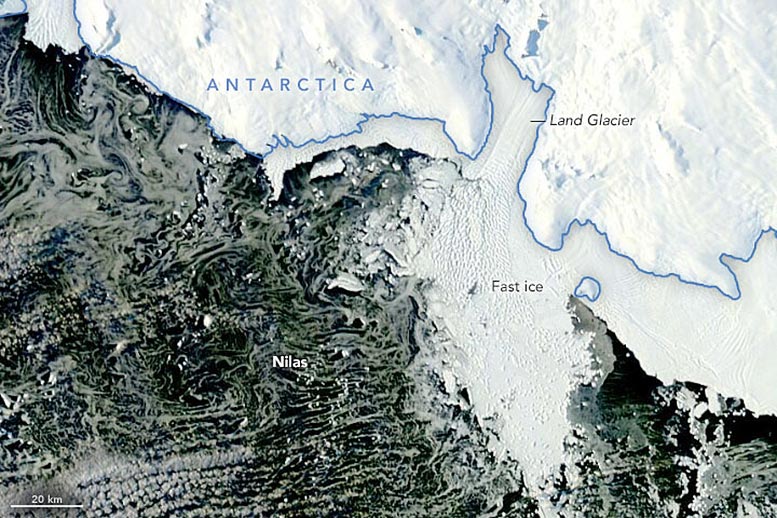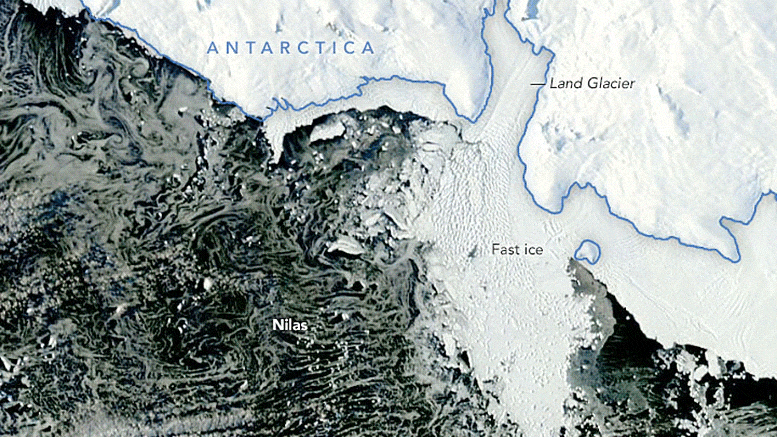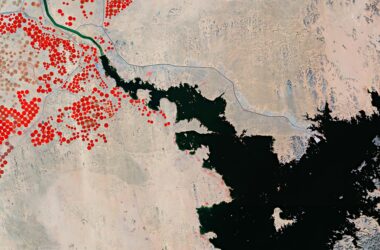
24 février 2022

23 mars 2022
En mars 2022, la vieille glace de mer s’est effondrée alors que de la nouvelle glace s’est formée au large de la côte de la Terre Marie Byrd en Antarctique.
La glace de mer autour de l’Antarctique a commencé à repousser après avoir atteint, fin février 2022, l’étendue la plus faible jamais observée dans les archives satellitaires. Mais à l’échelle locale, cette transition de la fonte au gel peut présenter des nuances. Par exemple, près du glacier Land, dans l’ouest de l’Antarctique, une zone de vieille glace de mer s’est brisée alors que de la nouvelle glace s’est formée en mars. Au même moment, une partie de la langue de glace du glacier s’est effondrée.
Michael Lowe, un analyste du Centre national des glaces des États-Unis qui a signalé les changements, a surveillé de près cette partie du littoral antarctique, connue sous le nom de Terre Marie Byrd. “J’ai gardé l’œil sur cette zone au cours des deux derniers mois, car il s’agit d’une grande zone de glace très ancienne”. glace rapide a commencé à se désagréger”, a déclaré Lowe. “En comparant deux SAR images de jours consécutifs, j’ai vu que l’extrémité du glacier terrestre commençait à se briser.”
Les changements sont également apparents sur cette paire d’images en couleur naturelle acquises les 24 février et 23 mars 2022 par le spectroradiomètre imageur à résolution modérée (MODIS) sur ;” data-gt-translate-attributes=”[{” attribute=””>NASA’s Terra and Aqua satellites, respectively.
The February image displays a vast expanse of sea ice fastened to the edge of the coastline, and to the Land Glacier’s ice tongue and icebergs. Lowe explained that this “fast ice” often has a symbiotic relationship with glaciers and icebergs. “The glaciers and grounded bergs allow sea ice to accumulate and ‘fast’ in a stable fashion,” he said. “This fast ice then helps anchor those bergs and glaciers as it thickens into old ice over years.”
But recent research using satellite observations showed that fast ice around parts of Antarctica, including off the coast of Marie Byrd Land, has been decreasing since MODIS records began around 2000. Still, a substantial patch remained at the time of the February image. By March, much of this old fast ice had broken apart.
According to Frazer Christie, a glacier geophysicist at the Scott Polar Research Institute at the University of Cambridge, the loss of fast ice may have had further consequences. It is possible, he said, that the quick evacuation of fast ice between February and March, in addition to the longer-term losses, may have contributed to the rifting and ultimate calving of Land Glacier’s ice tongue.
Christie points to a similar instance at the fast-flowing Totten Glacier in East Antarctica. There, losses of seasonal fast ice have caused the glacier’s front to speed up by as much as 100 meters per year. “An increasing body of research has begun to show the important role sea ice plays in congealing together and buttressing both ice tongues and ice shelves,” he said.
Notice in the March image that the icebergs appear to be turning west into the direction of the remaining sea ice. Christie explained that the bergs are being carried along with the Antarctic Coastal Current, which flows westward around the continent parallel to the coastline. The Coriolis effect will also influence the bergs’ flow, deflecting them toward the left of their path.
Iceberg calving is a natural process for glaciers that terminate in the ocean. “While Land Glacier has been observed to retreat, thin, and speed up in recent years, there is no evidence to suggest that its recent calving is related to anthropogenically forced climate change,” Christie said. “Instead, its behavior most likely reflects the natural calving lifecycle common to all Antarctic ice shelves and marine terminating glaciers.” The glacier last lost a similar amount of floating ice during the austral winter of 2004.
Another stage in the natural lifecycle of sea ice is visible in the March image: the growth of new sea ice. The smooth streaks and swirls are “nilas”—young ice that often forms thin sheets, generally no more than 10 centimeters thick. (Note that the green-yellow tinge is largely an effect of low light and automatic color corrections.) New ice that appears streaky is lining up with the direction of surface winds; ice that displays a swirling pattern is likely being pushed around by winds and ocean circulation patterns, or “eddies.”
As the next few winter and summer seasons come and go, scientists are curious to see what becomes of the glacier, icebergs, and sea ice off this part of Marie Byrd Land. Lowe added: “We’ll be watching to see if the bergs that broke off the Land Glacier ground and allow a new area of old fast ice to form over the next few years, restabilizing this area.”
NASA Earth Observatory images by Joshua Stevens, using MODIS data from NASA EOSDIS LANCE and GIBS/Worldview. Story by Kathryn Hansen with input from Christopher Shuman (UMBC/GSFC), Michael Lowe (USNIC), and Frazer Christie (U. Cambridge).



